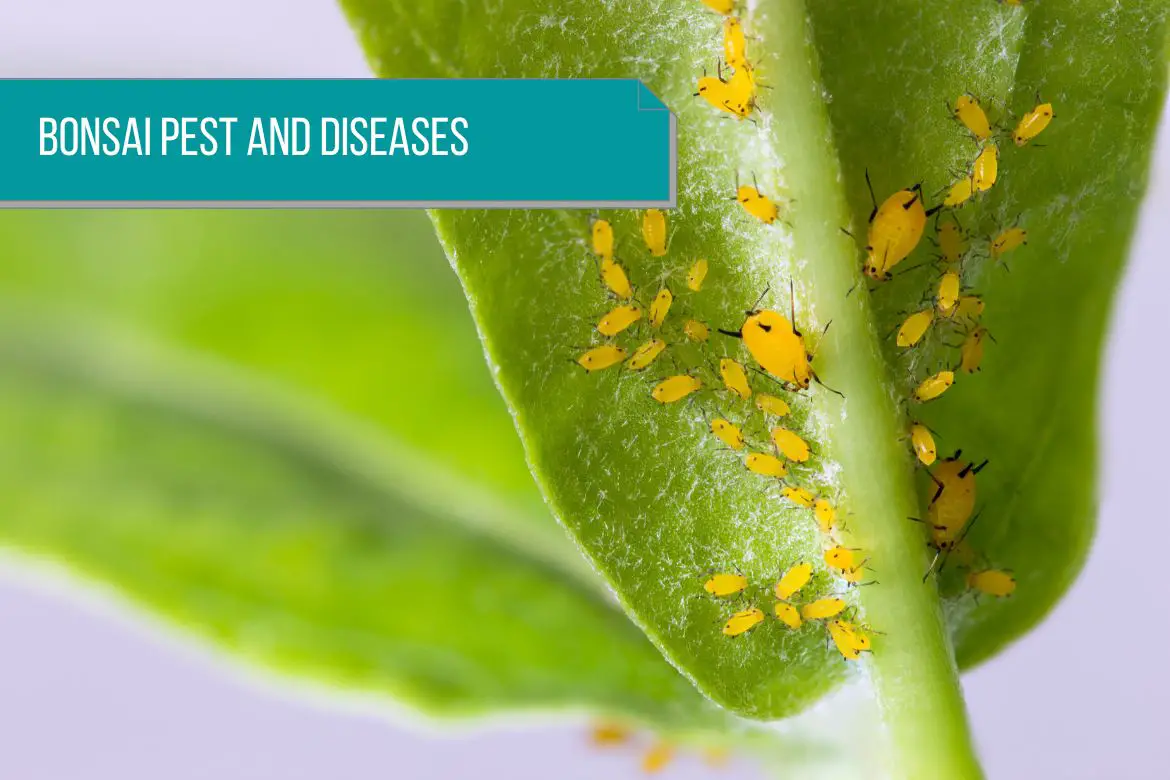As sensitive trees, bonsai require more care and precision in pruning, training, repotting, watering and fertilizing than other house or garden plants.
Having to live in such a restricted environment makes them particularly vulnerable to physical, chemical, and biological threats.
The biological threats include various pests and diseases.
Please refer to best practices to keep your bonsai free from pest and diseases to know more.
As with any other tree, shrub, or houseplant, bonsai trees are susceptible to pests and diseases. Read the care guide for all the bonsai trees species for more details.
As far as pests are concerned, the slight advantage bonsai trees have over regular trees is that the size of the tree allows manual control. This includes removing the pest by hand or moving the bonsai from an infested area.
On the other hand, when it comes to diseases, they cannot be precisely identified even after noticing the symptoms. This is because similar symptoms can occur because of physical or chemical threats such as over/under watering, over/under feeding, wrong sunlight, temperature and humidity exposure and so on.
Hence, before committing to a ‘treatment‘, make absolutely sure that the symptoms are because of a disease and not because of poor bonsai care.
It is important to note: It is rare for well-cared-for bonsai trees to fall ill, and even when they do, it is easy to cure them. It is generally weak bonsai that are attacked by pests and diseases.
In this article we will discuss :
Bonsai Pests (Identification & treatment)
- Ants
- Aphids
- Caterpillars (Leaf miners and leaf rollers)
- Woolly Aphid
- Red Spider mites
- Root aphids
- Scale Insects
- Vine weevils
- Bark Beetles aka bark miners
- Nematodes or eelworms
- Earwigs
- Thrips
- Slugs and snails
- Whiteflies
- Sciarid fly aka fungus gnat maggots
- Froghopper aka ‘cuckoo spit’
- Mealybugs
Bonsai Diseases (Identification & treatment)
- Black spot
- Coral spot
- Verticillium wilt aka verticilliosis
- Powdery Mildew
- Downy Mildew aka Botrytis / Gray mold
- Peach leaf curl
- Anthracnose
- Fire blight
- Needle cast
- Root rot
- Canker
- Rust
- Scab
Bonsai Pests
Most of the bonsai trees are generally trouble-free. However, there are a few pests (which if not taken care of in time) which might cause major destruction and even death of the plant.
Important note : While using the chemical controls mentioned for each pest, make sure to strictly follow the instructions given by the manufacturer.
There are 2 types of insecticide:
Contact insecticides: They works on the outside of the bonsai. Contact insecticides stick to the foliage surface and kill anything that lands on them.
Systemic insecticides: These insecticides works from the ‘inside’ of the bonsai tree. They circulate inside the bonsai and kills any insect which feeds on the sap of the tree.
1.1. Ants
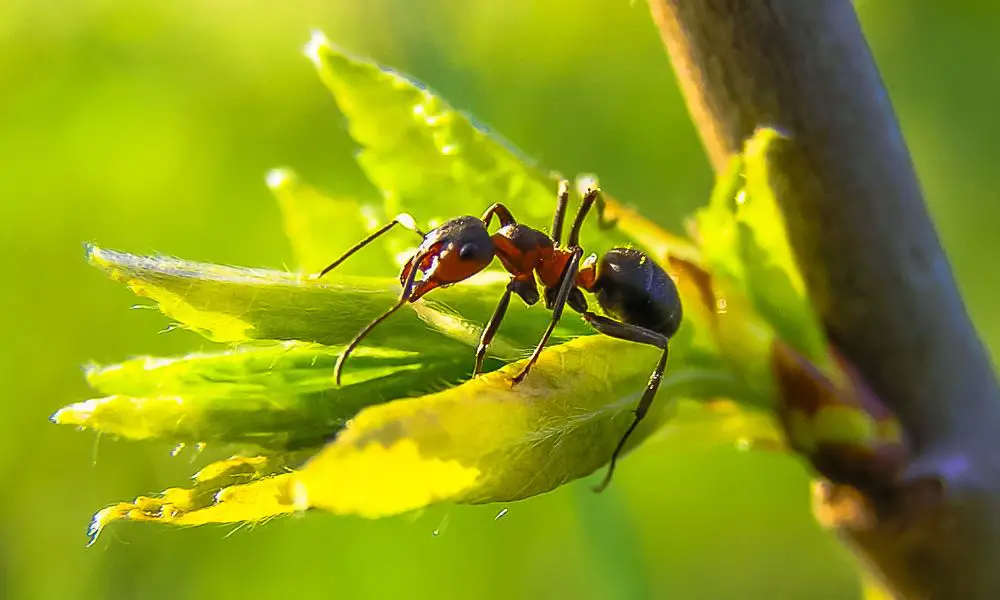
Aside from tunneling through the bonsai soil and building nests, or collecting the odd seed from the seed tray, ants do very limited damage to bonsai trees. Ants are generally on the tree to gather nectar from the flowers or fruits of the tree.
Ants do not damage the bonsai by cutting any foliage.
However, ants can also be tell-tale sign of the presence of aphids or any sap sucking insect or greenfly. The ‘honeydew’ produced by aphids specifically attracts the ants on the bonsai tree. Hence check your bonsai tree for aphids in case you notice infestation of ants.
Prevention and cure for ants on bonsai trees
Locate the ant nest and destroy it. Typically, the ant nest can be found near the bonsai tree. In case the nest is in the bonsai pot, repot the bonsai tree.
Furthermore, you can discourage ants by elevating your bonsai off the ground on a shelf or stand.
1.2. Aphids
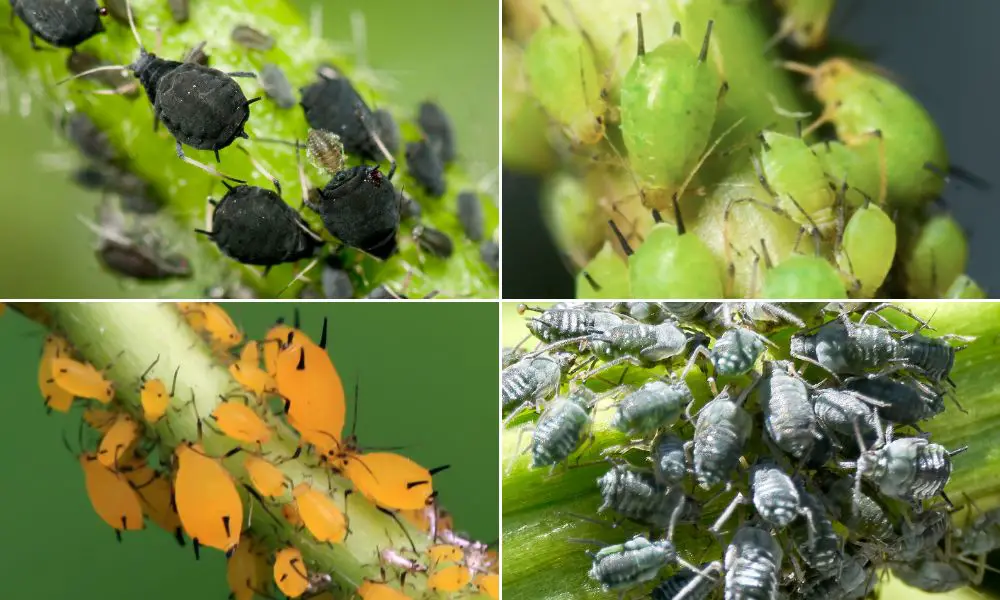
Aphids are the most common insects that attack bonsai trees. Insects of this type can be green, black, gray, or orange in color. Aphids can be greenflies or blackflies or gall aphids. They suck sap from the soft growing points of your plant (underside of the leaves and buds).
An aphid’s egg hibernates on the bark of a bonsai tree. In April, you will notice larvae starting to appear on the tips of the shoots.
Aphids are visible to the naked eye. Withering, curling and deformation of leaves and shoots are often one sign of aphids. Also, there will be a presence of ‘honeydew‘ on parts of the tree. This honeydew leads to the growth of sooty mold.
Conifers affected by this disease display shriveled needles with silver blotches and distortions. In the end, the needles will wither and drop.
Prevention and cure for aphids on bonsai trees
Organic methods:
- By spraying a jet of water on them, you can almost always get rid of aphids.
- After killing the aphids manually, remove the honeydew from the bonsai tree with a clean cloth.
- In 1 liter (0.26 gallons) of water keep 100 grams (34 oz) of fresh stinging nettle. This undiluted water can be used to treat aphids and whiteflies.
- Apply a spray of soft soapy water on the tree. (5 g of soap to 1 liter of water). Do not allow it to come in contact of the root ball.
- You can also apply a spray of rapeseed oil on the bonsai tree.
- Add 1 liter of boiling water to 3 grams of dried wormwood. Allow to steep for 15 minutes, strain, cool, and use undiluted to treat aphids, mites, and mildew.
- From mid-spring, sprinkle lacewing larvae on the tree (average temperature around 50°F (10°C)). One lacewing larva can eat almost 300 aphids.
Inorganic methods:
- If water spray does not work, use a spray of insecticides derived from plants or malathion or pyrethrum or fenitrothion or pirimicarb or Bifenthrin or organochlorine insecticides or organophosphate insecticides. Using organochlorine or organophosphate insecticides at the start of spring is recommended.
- Another option is to use a systemic dimethoate insecticide or a systemic organophosphate insecticide.
- Alternatively, you can also drench the soil with Imidacloprid.
- Tar oil can be applied to the bark of trees to take care of eggs laid by greenfly in the winter. Do this application at the end of winter before the leaves emerge. Spray the trunk and branches thoroughly after wetting them.
- The tree should be sprayed with mineral-based tar oils if infested by gall aphids at the end of the winter.
1.3. Caterpillars (Leaf miners and leaf rollers)
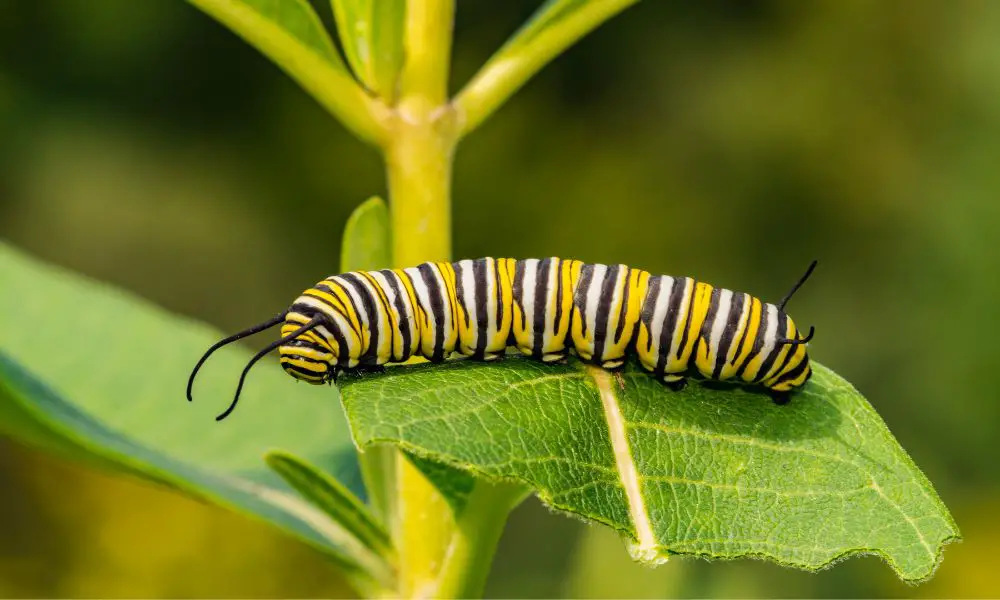
Generally, caterpillars appear in the spring to mid-summer on bonsai trees. A symptom of caterpillar presence is holes and missing parts of leaves.
Most bonsai are not affected by these pests, since a single caterpillar eating a leaf can be easily spotted and eliminated.
Several caterpillars pupate among bonsai foliage, sealing leaves together and lying inside, out of reach of birds.
Caterpillars are more attracted towards Crab apples, cotoneaster, Firethorn, juniper and pine (Aleppo pine tree bonsai, Mugo pine bonsai, Scots pine bonsai, Japanese white pine bonsai, Japanese black pine bonsai) bonsai trees.
In rare cases, caterpillars can destroy willow bonsai trees, appearing in large numbers and rapidly eating the foliage.
Some of the caterpillar and moths which attach bonsai trees are listed below:
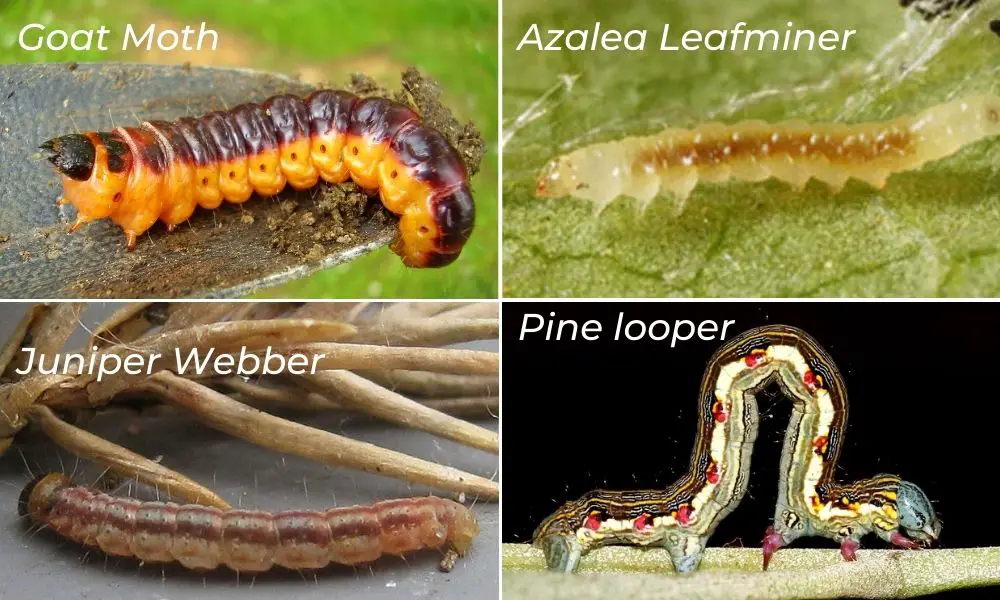
- Goat Moth , Leopard moth (Cossus cossus)
This caterpillar is rare and can attack oak bonsai trees, ash bonsai trees, elm bonsai trees (Japanese elm bonsai / Chinese elm bonsai ), beech bonsai trees and dozens of other types of bonsai trees. Unlike many other caterpillars which feed on the foliage of the tree, this pest feeds on the trunk of the tree. It can penetrate the trunk of the tree and survive there for a long period of time. - Azalea Leafminer (Caloptilia azaleella)
Azalea bonsai trees (eg Satsuki Azalea bonsai) are attacked by theses pests (mostly indoor bonsai). This caterpillar is green to yellow in color and causes the leaves to drop. It hides in the foliage by joining the leaves together with the help of a silk it produces. - Pine Looper (Bupalus piniaria)
This caterpillar is also known as ‘bordered white‘. It is green in color and feeds on the pine needles. The effected area turns brown in color. It also hangs from the branch of the bonsai tree using its silk thread. - Juniper Webber (Dichomeris marginella)
As the name suggests, this caterpillar attacks Juniper bonsai trees. This is a tiny, brown colored pest which rots the part of the tree which it attacks. The part of the tree will turn brown and when not taken care of in time, the tree part may even die (It may even result in the death of the entire tree).
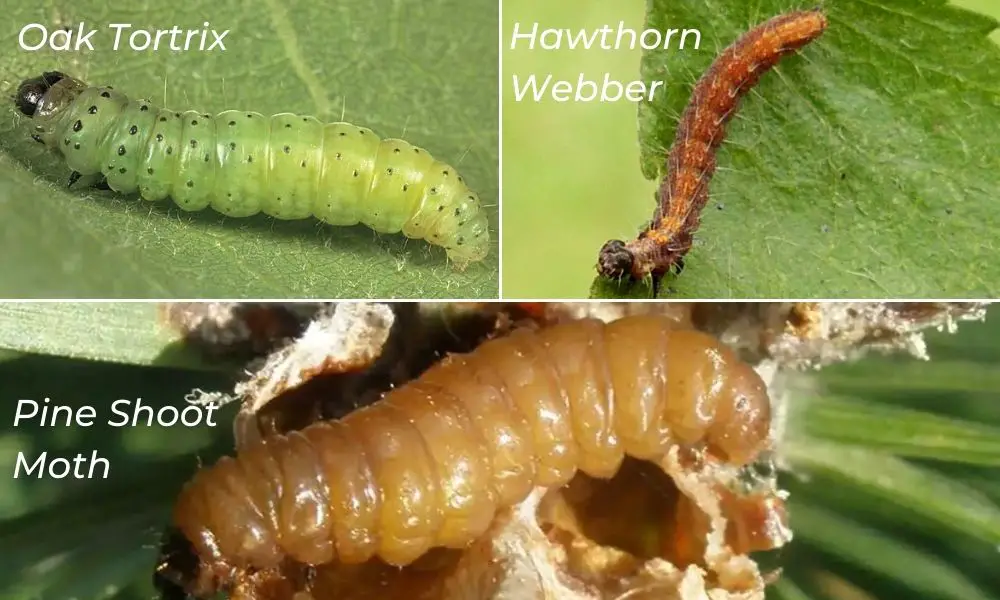
5. Pine tip moth (Rhyacionia buoliana)
This is a tiny caterpillar which in the winter months penetrates into the buds of the bonsai tree. It survives inside the bud and then becomes active when new growth starts appearing in the months of spring. As a result, detecting this caterpillar becomes a bit challenging. To prevent this pest, preventive measures should be taken.
6. Oak Tortrix (Tortrix viridana)
This caterpillar joins the leaves of the bonsai tree and feeds on the tree. It also hangs from the branch of the bonsai tree. In addition to this, other forms of Tortrix can also attack your bonsai tree.
7. Hawthorn moth (Scythropia crataegella)
It is known that this caterpillar attacks hawthorn bonsai trees as well as cotoneaster bonsai trees. These are red, yellow or brown in color.
8. Geometer moths (Geometridae)
Foliage is eaten away by caterpillars, and buds are punctured. Caterpillars can climb down between the foliage and the soil with the help of silken threads.
Prevention and cure for caterpillars on bonsai trees
Organic methods:
- The easiest way to remove caterpillars or cocoons is by hand.
- You can also alternately apply systemic and contact insecticide. In case of flowering bonsai trees, spray before and after flowering. Do not spray at the time of flowering.
- The leaves which are stuck together by the caterpillar can be pulled apart and the pupa can be removed.
- You can also spray a diluted solution of soapy water on the tree. (5 g of soap to 1 liter of water). Do not allow it to come in contact of the root ball.
Inorganic methods:
- As a precaution, you can also apply a spray of malathion.
- The first sign of damage should be treated with an insecticide containing Bacillus thuringiensis var. kurstaki (btk). Make sure the leaves are thoroughly sprayed. In the event that the plant becomes re-infested, respray immediately.
- For geometer moths on bonsai, you can use lindane or parathion-based synthetic insecticides during the spring season. In winter, you can destroy its eggs using an oil-based product.
- For leaf miners, you can spray some organophosphate insecticides.
1.4. Woolly Aphid
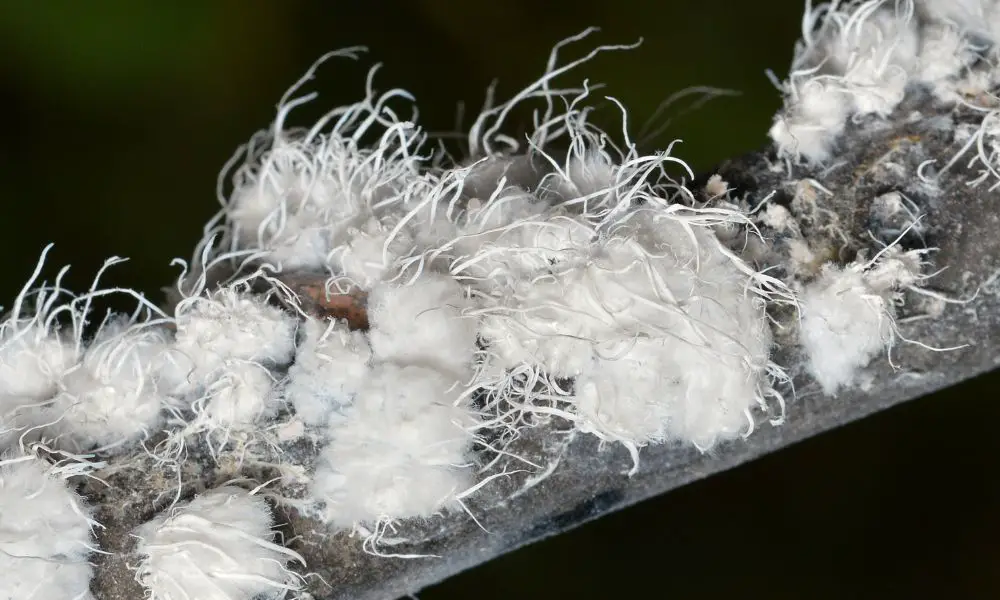
This is a brown aphid that covers itself in a white, woolly wax and poses a serious threat to bonsai trees.
These aphids look like white cotton balls and build up around stems and branches, giving the bonsai an unsightly appearance.
Both the above-ground and below-ground woody parts of the tree are attacked by woolly aphids.
Galls are formed as a result of them penetrating the surface. This can lead to the development of fungus and slow growth of the bonsai tree.
The woolly aphid is also a sap-sucker. It feeds on the fine, twiggy branches of various species of bonsai trees, particularly those with fruit and flowers, like crab apple bonsai, cotoneaster bonsai and hawthorn bonsai. It also feeds on pines bonsai (Japanese white pine, Aleppo pine tree, Mugo pine, Scots pine, Japanese black pine ), Beech bonsai, Firethorn bonsai, and larch bonsai.
Branches that have been attacked may die back. In case of crab apple bonsai, cankers may form.
Prevention and cure for woolly aphids on bonsai trees
- If you have pine bonsai trees, make sure to hose off as many woolly aphids from the tree without dislodging them to other nearby trees.
- The tree should be sprayed three times during the first week, then the woolly residue should be washed off and the insecticide should be applied once a week for three weeks.
- It is possible to remove small colonies of woolly aphids by dampening a cloth or soaking a cotton bud in methylated spirits or rubbing alcohol.
- Woolly balls should be separated and then the pests should be treated the same way as other aphids.
- For better penetration of the insecticide through the thick outer coat of the insect, mix few drops of detergent in the insecticide.
- After removal of the gall, treat the wounds on the tree with a copper based solution.
- During the winter, spray tar oil on the trees. Another variation of tar oil should be sprayed when new growth appears. The buds should be treated with oleoparathion when they begin to open. Spray insecticides on the tree while it is in leaf.
- A systemic insecticide can also be used.
- Apply a spray of Malathion to the tree.
- Additionally, you can also apply Imidacloprid on the bonsai soil.
1.5. Red Spider mites
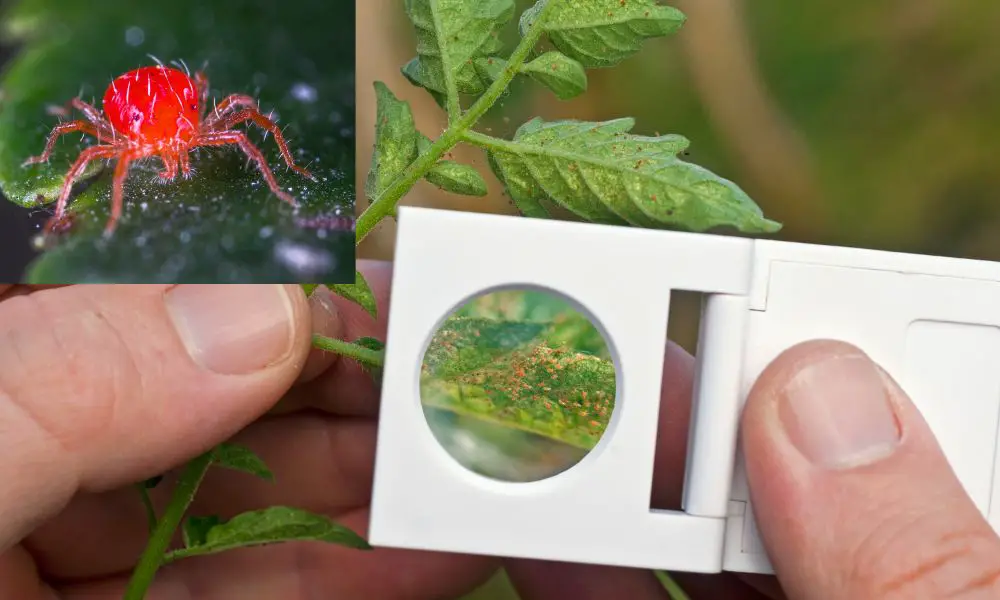
An unaided eye can barely see the bonsai tree mites, which range in color from yellow white to orange and brick red.
If you suspect your plant is infested with spider mites, tap a branch with white paper underneath it. Specks of green, red, brown, or yellow color that fall on the paper and crawl around are mites. (Red powder like paprika)
Another way of detecting these mites is by looking for their old skin which is produced every time the larvae moult. These shells look like white dots on the underside of the tree.
In several larval stages, these tiny arachnids suck on plants. Leaves become dull, mottled, and yellowish green in color. Eventually, the foliage turns brown and falls.
During their feeding on leaves and stems, mites produce fine webbing, which collects dust and dirt.
Flowering and fruiting bonsai, spruce bonsai, holly bonsai, Needle juniper bonsai, Chinese elm bonsai, and ficus bonsai are particularly susceptible to mite infestation.
Some varieties of ficus (for example, Ficus benjamina bonsai – weeping fig) can tolerate mite infestation to a certain extent.
Some bonsai species, however, lose their entire foliage very quickly. In the case of new growth becoming infested and dying off, the bonsai tree is unlikely to survive.
It is worth nothing that there are different types of mites such as Conifer Mite (Oligonychus ununguis), Fruit Tree Red Spider (Panonychus ulmi) and Red Spider Mite/Glasshouse (Tetranychus urticae & Tetranychus cinnabarinus).
As the name suggests, Conifer Mite attack conifer bonsai trees such as juniper and pine.
Fruit Tree Red Spider is specially attracted to fruiting bonsai trees such as crab apple bonsai or peach bonsai.
Red spider mite or carmine spider mite attacks all kinds of bonsai trees (more attracted to indoor bonsai trees).
There are some species that are active during a warm, dry growing season. Others, such as those infesting conifers, prefer cooler temperatures and are active during spring, autumn, and winter during warm spells and in ‘mild winter’ weather.
When hot weather arrives, these mites cause maximum damage.
Prevention and cure for Spider mites on bonsai trees
- Pruning away and burning infested branches is the most effective treatment.
- Spraying some rapeseed oil, or malathion or Bifenthrin or any product containing dienochlor, can be helpful as a preventive method. You can also use Kelthane, Metasystox, or Orthene.
- You can also drench the soil with Imidacloprid.
- The majority of commercially available sprays are only effective against mature adult mites. Certain larval stages and eggs are not affected. As a result, the treatment must be repeated several times.
- In addition, predatory mites can be introduced into the room. Plant-eating mites will be attacked and eaten by them without causing any damage to the bonsai. In specialist shops, you can buy predatory mites. Phytoseiulus is a tiny harmless mite that can be applied to trees as a predatory mite.
- Organic treatment: Add 1 liter of boiling water to 3 grams of dried wormwood. Allow to steep for 15 minutes, strain, cool, and use undiluted to treat aphids, mites, and mildew.
- A systemic insecticide which you can use can be something containing dimethoate or oxydemeton-methyl.
- It is not recommended to use systemic insecticides on Chinese elms bonsai as this can cause the leaves to drop.
- Once the new growth appears at the end of winter, spray with tar oil to destroy the eggs.
- Apply systemic acaricides in the spring.
- The use of specific acaricides in the summer is recommended. However, make sure that you apply this treatment with caution, or else the bonsai tree will be damaged.
- Heat and dry conditions are ideal for mites, but humidity is not. Therefore, it is essential to thoroughly mist the foliage (specially during summer). Misting greatly reduces the risk of infestation development. However, do not mist the soft-textured leaves and flowers.
- Spray plants with water, insecticidal soap, neem oil, or a miticide as soon as you see damage. Be sure to follow the directions on the label and only buy products that list your plant on the label.
1.6. Root aphids

There are some aphids that live in the soil and eat roots and damage plants. Symptoms include yellowing and wilting foliage.
These moldy grey creatures look like black flies. Colonies of these insects live in the root system of bonsai trees (especially pine bonsai trees).
They feed on tree roots and are often mistaken for beneficial mycorrhizal fungi.
Prevention and cure for root aphids on bonsai trees
- In order to determine whether the tree is infected, you can lift the tree out of its dish and inspect the roots for tiny grayish-white growths, which resemble cotton wool balls.
- It is tricky to treat bonsai due to their sensitivity to chemicals, but washing-up liquid treatment may be effective. Afterward, fresh, sterile soil can be used to repot the bonsai.
- It is recommended that you apply a solution of metasystox directly on the soil as a treatment.
- The roots and root ball of the plant can even be drenched with a systemic insecticide in order to eradicate insects. At intervals of 10 to 14 days, repeat this process several times if needed.
1.7. Scale Insects

Scale insects can be categorized into hard and soft shelled types.
A hard scale insect with a hard shell is a sedentary insect (because they lose their legs after molting) that colonizes the leaves, the fruits, and the branches of the bonsai. Their shells are covered with a waxy coating, ranging from gray-brown to dark-brown color, and measure about 3mm in diameter. Some hard shell scale insects are listed below:
- San Jose scale (Quadraspidiatus perniciousus)
- Scurfy scale (Chionaspis furfura)
- Hemlock scale (Abragallaspis ithacae)
- Juniper scale (Carulaspis juniperi)
- Euonymus scale (Unaspis euonymi)
- Obscure scale (Melanaspis obscura)
- Pine needle scale (Chionaspis pinifoliae)
- Oystershell scale (Lepidosaphes ulmi)
On the other hand, the shell of the soft scale insect is part of its body. Hence they do not lose their legs after molting and are not sedentary. In terms of shape, they are convex and round. Some soft shell scale insects are listed below:
- European elm scale (Gossyparia spuria)
- Tuliptree scale (Toumeyella liriodendrii)
- Magnolia scale (Neolecanium cornuparvum)
- Cottony maple scale (Pulvinaria innumerabilis)
- Fletcher scale (Parthenolecanium fletcheri)
- Spruce bud scale (Physokermes piceae)
- Pine tortoise scale (Toumeyella parvicornus)
The first sign of infestation is when a plant becomes sticky.
It looks like there are clusters of waxy shells on the leaves, sides of the trunk, and on the branches. Scale insects live inside each shell. Honeydew is excreted by them, damaging the leaf blade and breeding sooty mold, a black fungus. A bonsai tree’s trunk becomes distorted, its branches die, and its leaves (or needles) turn yellow and drop off.
Scale infestations can kill a bonsai after two or three seasons if left uncontrolled.
Fruit and nut bonsai trees, Ficus bonsai trees, zelkova bonsai trees, elm bonsai trees (Japanese elm bonsai tree, Chinese elm bonsai tree) , azalea bonsai trees, maple bonsai trees (Hedge maple bonsai, Seigen maple bonsai, Kiyohime maple bonsai, Japanese red maple bonsai, Japanese maple bonsai, Amur maple bonsai, Trident maple bonsai), ivy bonsai trees, juniper bonsai trees, oak bonsai trees, Hemlock bonsai trees and many more can be affected by scales.
Prevention and cure for scale insects on bonsai trees
- It is possible to scrape off young scales with a stick or toothpick, or simply rub them off with your fingers or fingernails.
- The infested branches should be cut off and destroyed.
- When you are scraping the scale insects, make sure to cover the pot surface. When a mother scale drops on the bonsai soil, it will hatch young scales in the soil. These young scales are mobile and at this stage they are known as crawlers.
- Crawler stage is easiest to control.
- The infested tree should be isolated from other bonsai or plants.
- You should be cautious when treating fragile bonsai varieties: too much treatment could cause death.
- A cotton swab soaked in methylated spirit can be used to paint on and around the scales.
- Dormant oil sprays or a combination of borax and kerosene can also be used to control scale infestation.
- However, colonies that are well-established and large are difficult to remove; use a systemic insecticide.
- A systemic insecticide containing dimethoate can do the trick for you.
- A 15 per cent malathion emulsion can also be sprayed on your tree several times.
- You can even use Kelthane, Metasystox, or Orthene insecticide. Make sure to follow the instructions mentioned on the label.
- If it is allowed in your region, you can even use steinernema nematodes. These are natural predators of many pests found in plants.
- Ladybirds are also natural predators of scale insects.
1.8. Vine weevils
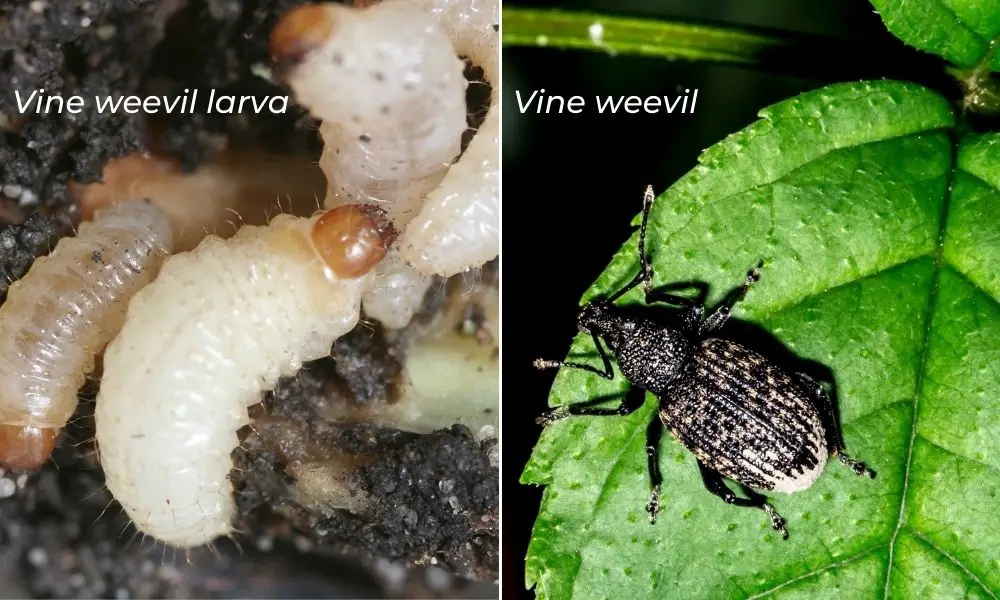
Both adult beetles and larvae are dangerous to the bonsai plant. These can even prove to be deadly to the bonsai if the root system of the plant is attacked.
There is a thick snout on the beetles which are dark in color and covered with tiny hairs. These beetles are mostly active in the night.
From early spring to late summer, the larvae of these beetles are highly active. Vine weevil larvae are about 1.25 cm long, creamy/lemony white, fat, curved and have a brown head. Because of their color, they can easily be spotted in the soil.
Vine weevils are prone to spreading rapidly in a container garden.
It is known that the adult, which lays many eggs, feeds on notches in the leaves of plants while the larvae feed on roots with a seemingly insatiable appetite.
In most cases, attacks on leaves are immediately visible, but damage to the roots is only noticeable when the plant begins to wilt. (even when the bonsai compost is not dry)
The tree may show unusual or explainable deterioration, which is one of the symptoms of vine weevil infestation.
Prevention and cure for Vine weevils on bonsai trees
- As stated earlier, the larvae are easy to spot on the soil. Remove and destroy them as soon as you find them.
- At the time of repotting, check the soil for tiny, legless, creamy-colored grubs.
- In case the soil is contaminated, soak the soil in insecticide or change the bonsai soil.
- It should be noted, however, that some weevil larvae are much smaller than others. An effective treatment is a soil drench of gamma-HCH (gamma–hexachlorocyclohexane / γ–HCH), which will kill beetles and larvae.
- The beetles should be picked off as soon as they are seen.
- These beetles can not fly. Hence you can also line the area around the bonsai pot with some grease or a sticky compound to limit the attack from the beetles.
- Biological controls, like parasitic nematodes (Steinernema feltiae (Entonem) and Heterorhabditis bacteriophora (Larvanem)) can also be applied.
- You can also add some chlorpyrifos to the soil or spray some Imidacloprid on the soil.
1.9. Bark Beetles aka bark miners
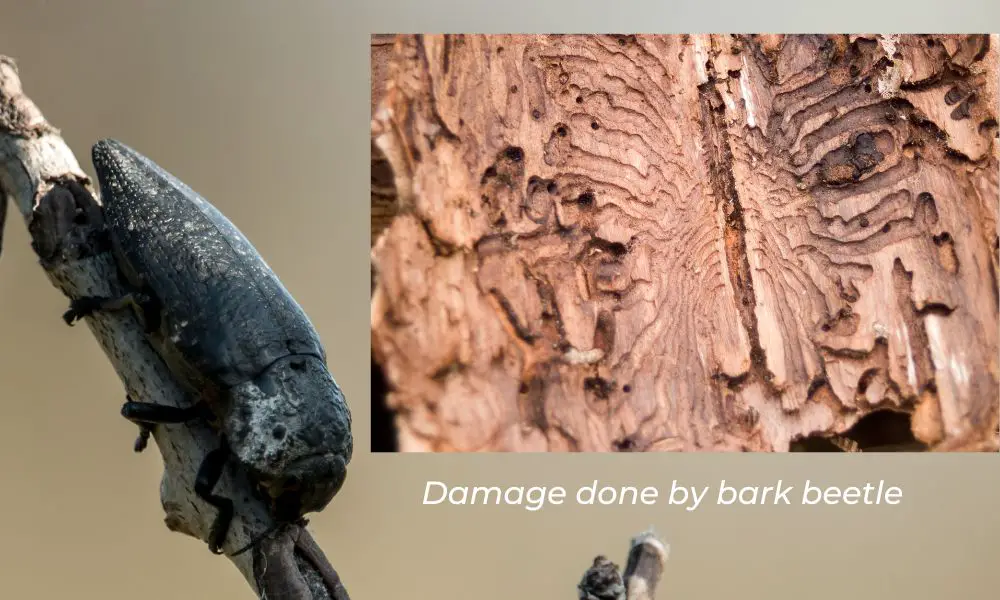
Approximately 1 to 5 mm in length, these cylindrical beetles are black or brown.
The creatures live in the wood or under tree bark, where they dig tunnels and cause significant damage to the bonsai tree. Conifer trees are the main victims of bark beetles.
This insect creates longitudinal tunnels between the bark and sap wood in which the eggs of the bark beetle are sheltered.
After hatching, the larvae of this insect begin tunneling as well. These larvae tunnels are generally at a ‘right-angle’ to the parent tunnel.
Also, these tunnels are home to many types of fungus. As a result of the damage to the wood, some branches die back as a result of the reduced nutrition distribution in the plant.
Another symptom of this pest infestation is the bark of the tree will have holes in it. This is because adult beetles will try to penetrate through the bark to come outside.
It should also be noted that these insects are carriers of Dutch Elm disease as well.
Prevention and cure for bark beetles on bonsai trees
- The affected branches should be removed and destroyed as soon as possible.
- It is helpful to enrich the soil with potassium and phosphorus.
- During the second half of April, spray the trunk and branches with a parathion and lindane–based insecticide to destroy the adults on the bark and, if necessary, spray them again in July to kill any remaining adults.
- At the end of winter, spray just a thin film of oleoparathion on the larvae to destroy them.
1.10. Nematodes or eelworms

A root nematode is a microscopic worm that lives in the soil. Moist and sandy loam soil is conducive to nematodes. It is thought that they move a few inches every year, but dirt, water, dirty bonsai tools, or plants infested with them can carry them long distances. Continue reading How to keep your bonsai tools clean.
There are varieties that are beneficial to plants, while there are others that feed on their roots.
Nematode presence is indicated by warty growths on the roots. In certain rose species, such as a Quince bonsai and a Cotoneaster bonsai, wart-like swellings appear on their roots.
Nematodes damage and enlarge the roots. This makes the roots unable to supply nutrients and water to the plant above.
Sluggish growth and tiredness in growth performance are the most common symptoms. There are a number of symptoms of infestation, including premature drop of small discolored leaves, twig and branch dieback, and deteriorating plant health.
However, it is also worth noting that the same symptoms are also produced when the bonsai tree is overwatered, drought stressed, nutrient deficient, has root rot or is planted on soil with poor structure.
Therefore, if you want to be absolutely certain that your bonsai is actually affected by nematodes, sending a soil and root sample to a lab is a wise idea.
Some of the nematodes which can be found on the bonsai trees are mentioned below:
- Root-knot nematodes : It pierces the roots of the tree and causes strings of galls to develop as a result. In addition to protecting the worms, the galls distort the roots as well.
- Root-lesion nematodes : Whenever they build nests on the roots, they cause canker in the roots, thereby damaging the roots to the point where they die. There is a yellowing of the foliage. It is also possible for fungi to develop.
- Ectoparasitic nematodes : There are many Ectoparasitic nematodes. As the name suggests, these nematodes attack the roots by consuming the outer tissue of the roots. It slows down the growth of the bonsai tree. There is a gradual yellowing of the foliage, starting at the base of the tree and progressing to the top. Furthermore, these nematodes also carry viral diseases.
- Cyst nematodes : The rootlets overdevelop as a result of this nematode. In addition, it causes root rot.
Prevention and cure for nematodes on bonsai trees
- You can minimize your bonsai’s stress by mulching, watering, and fertilizing it.
- Nematodes can be controlled by repotting frequently.
- Rosaceous plants with sudden foliage wilting can be examined in spring or in August for nematode problems.
- It is generally effective to spray a systemic fungicide directly on the cut after removing the nematodes with a sharp knife.
- You can also completely replace the soil with a bonsai soil which is high in mycorrhizal activity. (eg. mixed with pine needles). Read how to make bonsai soil for more details.
- The humus content of the soil will lead to the production of other eelworms which help in eliminating harmful nematodes.
- There should be a great deal of caution taken not to confuse the frills of mycelium, which are a yellow-white color when healthy, and positive to the plant, with the blue-white root cover produced by root aphids. Check the aphids with a magnifying glass if you are unsure. They appear as distinct round bodies when viewed through a lens.
1.11. Earwigs

In spite of their intimidating look, the danger of earwigs is not as high as that of other pests. They have a flat body and have pincers known as “cerci” on their tail end. Be careful while handling them as they are also known to ‘pinch’ when sensing danger.
They are more likely to inhabit a warm and humid location. Read choosing bonsai location for more details.
They are omnivores and eat just about everything. They usually eat the dead and decaying parts of plants and animals. And as the population increases, earwigs will start feeding on the live parts of the plant.
They have a tendency to hide and survive during the day and come out to feed at night.
It is also important to note that they also feed on harmful pests such as aphids and insect eggs. So you can say, they too have their advantages.
Some of the symptoms of the earwig on your bonsai are partially eaten leaves, leaves and flowers with holes, earwig feces.
Prevention and cure for earwigs on bonsai trees
- It is important to remove all weeds, dead & fallen plant debris from the surrounding area. Keep the area clean.
- Make sure to check the underside of the bonsai container.
- Most of the damage is caused by earwigs during the rainy season. Because this is the time of year when these pests look for dry shelter and a place to hide.
- You can rinse the plant with diluted soapy water. (5 g of soap to 1 liter of water). Do not allow it to come in contact of the root ball.
- You can even make a homemade insecticidal spray by mixing water and 95% alcohol in the ratio of 3:2. Spray this mixture on the pest.
- You can also spray BHC (benzene hexachloride).
1.12. Thrips

Although these tiny black insects rarely affect indoor bonsai in the house, they can sometimes attack bonsai trees in the garden that are kept outside during the summer months.
In solariums, sunrooms, and greenhouses, bonsai trees are often infested with thrips.
The tiny dark brown fly-like insects have light-colored wings and jump from plant to plant where they feed by piercing and sucking the sap from the leaves (eating the lamina) and flowers of plants, causing fine silvery mottling and streaking on the leaves and flowers.
It is common to see flowers that become distorted and the undersides of leaves that show small globules of red liquid. These globules eventually turn black when severe infestations occur.
Prevention and cure for thrips on bonsai trees
- In the event that thrips are noticed, spray the plants several times with a systemic insecticide as soon as possible.
- You can also spray some Rapeseed oil on the bonsai tree.
- Drenching the bonsai soil with Imidacloprid is also effective against thrips.
- There is also the option of spraying with Malathion, Bifenthrin or Pyrethrum as a method of controlling them.
1.13. Slugs and snails
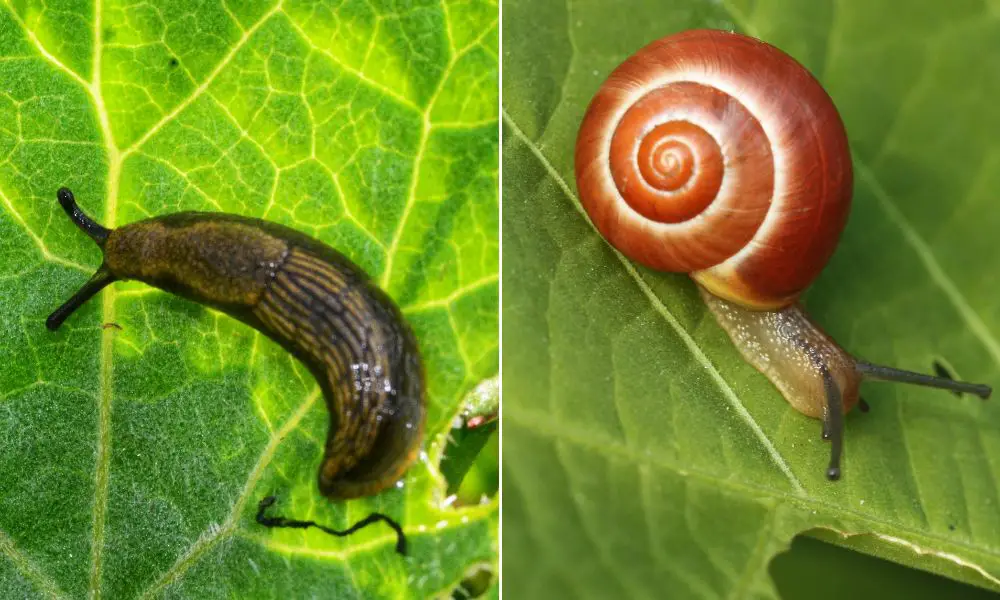
A high-humidity environment or an outdoor location in summer can make slugs and snails a problem for your bonsai. Snail is similar to slugs, though snails have hard shells.
Outdoor bonsai trees are more affected by these pests.
Through their sense of smell, these pests can detect soft, young shoots and leaves. Their feeding causes considerable damage to leaves, stems, and roots.
Furthermore, slugs and snails cause more damage to newly propagated plants.
Most of the time, they are hidden during the day and active at night.
In comparison to slugs, snails are less bothersome, but they do burrow in the soil.
One of the indicators of their presence are leaves with ‘smooth-edged’ holes. Another sign of their presence is the glistening trail of slime they leave behind on the plant, on the soil and around the bonsai pot.
Prevention and cure for snails and slugs on bonsai trees
- Follow the trail of slime they leave behind and remove them from the area.
- Keeping the bonsai pot on a raised platform to prevent them from climbing the tree.
- You can use a shallow tray containing a small amount of beer (or sugar water) as a bait to lure these pests away. Leaves of cabbage also attracts snails and slugs.
- You can also use slug baits available in the market. While placing bait, wet the area so that you increase the chances of their activity in the night.
- As these pests are more active in the night, inspect your bonsai tree in the night with a flashlight.
- Spread slug pellets around infected trees to poison them. However, avoid slug pallets if you can. Go for other remedies mentioned here.
- Every morning, remove dead slugs and snails and make sure that family pets and wild animals cannot reach the slug bait.
- Since slugs dislike moving over sharp fine gravel, standing pots on this material makes bonsai less accessible to them.
1.14. Whiteflies
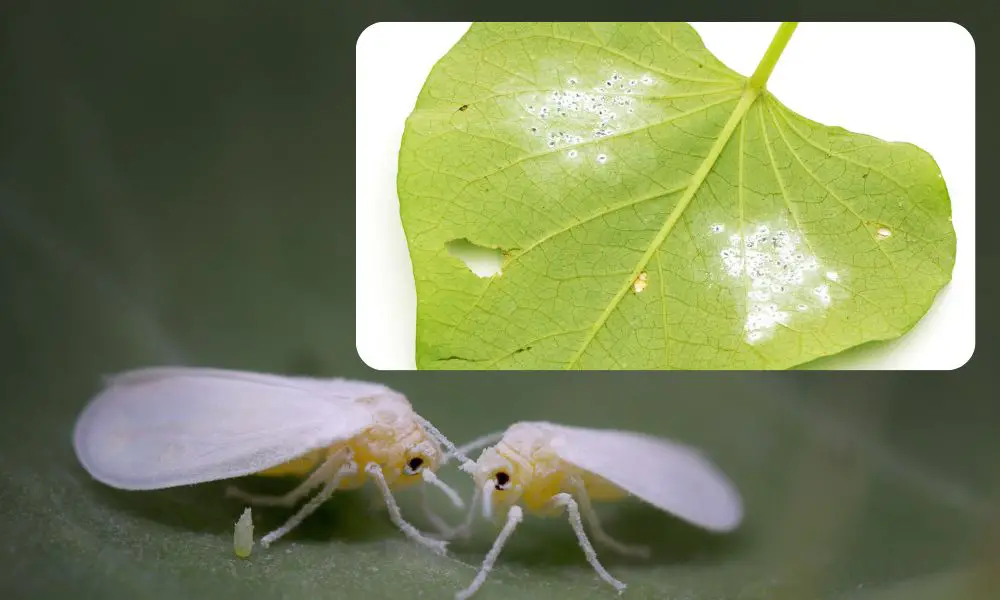
Whiteflies also known as ‘Greenhouse whiteflies’ Symptoms A honeydew with a sooty mold forming on it. Presence of flies on the lamina.
The adults of these insects resemble tiny moths, although they are related to aphids.
In greenhouses and solariums, these flies infest the soft tissue of indoor bonsai trees. Stale air and a dry environment are ideal for them.
They flutter from plant to plant when disturbed (this can also be used to check the presence of these pests). Young green nymphs of this species live mostly on the leaves’ undersides (lamina), sucking sap and excreting honeydew. This promotes the growth of sooty mold. Also this fungus deprives the plant of light.
Over a certain period of time, mature females lay a few eggs every day, so new creatures hatch every day, making control more difficult. These larvae are the main source of damage to the tree. During their larval stage, these white insects suck the plant sap.
Young beech bonsai trees and crab apple bonsai trees are occasionally affected by them. Also, Fuchsia bonsai, sageretia bonsai, hibiscus bonsai (eg. China rose bonsai ) and dwarf pomegranate bonsai are especially susceptible to attack. Other species, however, are also susceptible.
Infected bonsai leaves turn yellow, then black, and eventually fall off due to sooty mold. Yellowing leaves can be the first symptom of a whitefly infestation. Also the upper side of the leaves will have a yellow colored dotted pattern.
Prevention and cure for Whiteflies on bonsai trees
- It is common for insecticides to kill only mature whiteflies. Furthermore, the fact that they fly makes it difficult for infestations to be contained.
- The yellow whitefly trap has proven to be effective. It is the yellow color of the traps that attracts these insects. When they land on them they stick to the birdlime that is on the surface of the traps.
- In addition to this, it is also possible to purchase a parasitic ichneumon wasp to combat whitefly infestations.
- Organic treatment: In 1 liter (0.26 gallons) of water keep 100 grams (34 oz) of fresh stinging nettle. This undiluted water can be used to treat aphids and whiteflies.
- Use both organophosphate insecticides and acaricides. And keep alternating between these products so that the whiteflies are not able to build immunity to either product.
- Rapeseed oil can be sprayed on the tree.
- Malathion should be sprayed on both the eggs and the flies so that they can be destroyed.
- You can also use a spray of bioresmethrin, Bifenthrin, Resmethrin, or Orthene.
- Or you can use dimethoate as a systemic insecticide.
- Pyrethrum can be sprayed on beech bonsai trees and crab apple bonsai trees. Other trees can be rinsed with diluted soapy water. (5 g of soap to 1 liter of water). Do not allow it to come in contact of the root ball.
- You can also apply Imidacloprid to the bonsai soil.
1.15. Sciarid fly aka fungus gnat maggots

Often called fungus gnat maggots, sciarid-fly maggots feed on the roots of young plants, especially in damp, humid conditions.
A fungus gnat is a small fly that inhabits soil, potting mix, other container media, and other organic decomposition sites. They are specially attracted to moist and organically-rich soil.
Adult fungus gnats don’t damage plants or bite people; their presence is primarily considered a nuisance.
Larvae, however, can damage roots and stunt bonsai growth if they are present in large numbers, particularly on seedlings and young plants. It has been observed that indoor bonsai trees suffer significant root damage, and in some cases, they die.
Wilted bonsai tree is one of the symptoms of this pest infestation. However, before jumping into a conclusion make absolutely sure that the wilted nature of the tree is not because of poor bonsai care.
Bonsai trees in nurseries and greenhouses are more likely to get attacked by fungus gnat maggots.
Outdoor bonsai trees are also attacked by larvae that feed on the roots. However, they rarely cause major damage to the trees.
Prevention and cure for fungus gnat maggots on bonsai trees
- Apply some Imidacloprid to the bonsai soil.
- Also, watering the compost with a Malathion solution can be beneficial.
1.16. Froghopper aka ‘cuckoo spit’

The froghopper, or cuckoo spit as it is also known, is a jumping insect that lives in frothy, spit-like bubble nests.
They are typically found on the undersides of leaves and at the junction of stems and leaves.
Pushing your finger into the bubbles reveals a pale-green insect that invariably jumps away.
It feeds on the sap of the plant, weakening the bonsai tree. There is also wilting of leaves and distortion of shoots.
Prevention and cure for Cuckoo spit/froghopper on bonsai trees
- There is a systemic approach to the removal of frog hoppers. Because it hops away when it is disturbed, usually to a nearby plant or bonsai tree.
- Spray water or wipe a damp cloth on the frothy spit to remove it.
- An insecticide should also be applied thoroughly to the infected area and to the froghoppers.
- Boric acid (specifically 0.4%), Permethrin and Imidacloprid can be used to eliminate these bugs.
1.17. Mealy bugs
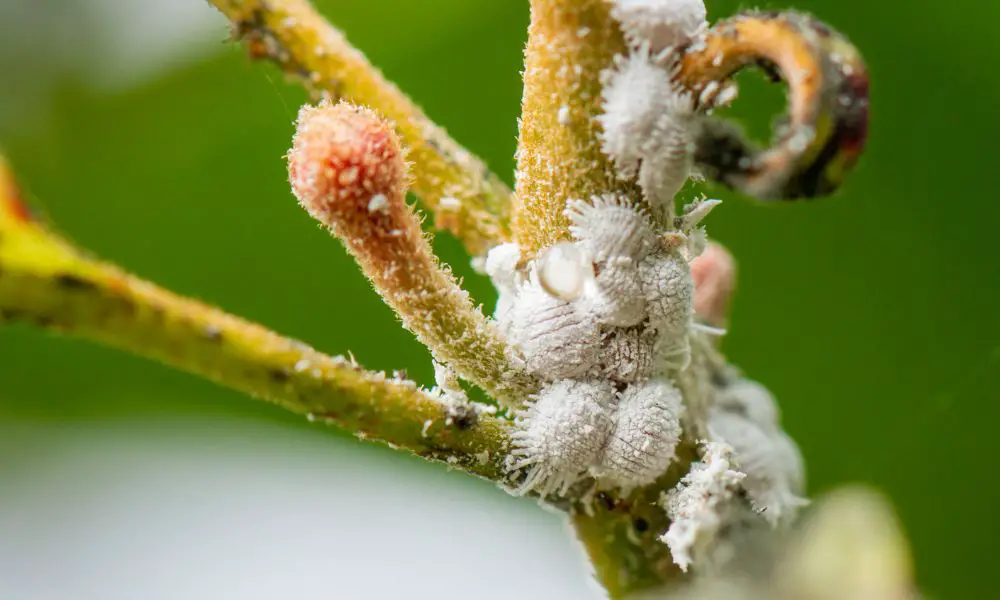
Mealy bugs and woolly aphids look very similar at first glance. Usually occurring around young shoots of trees, both types of infestations appear as white downy clusters.
They mostly attack indoor bonsai trees. They can also attack hardy outdoor bonsai trees in very warm summers.
Typically, mealybugs infest the branches (leaf joints, stems and leaves) and trunks of bonsai, but sometimes they can also infest the roots. They weaken the bonsai by sucking on its sap rendering it unsuitable for bonsai training. The infected leaves turn yellow and drop.
They also excrete honeydew, which encourages the growth of sooty mold.
Prevention and cure for Mealybugs on bonsai trees
- Mealybugs thrive in warm temperatures. Therefore, keep the bonsai in a cool, well ventilated place.
- If you find a bonsai with mealybugs, isolate it from other plants until it is completely free of the pests.
- Cotton swabs dipped in methylated spirits or rubbing alcohol can be used to wipe away light mealy bug infestations.
- For major infestations, implement a spraying program that alternates between contact and systemic insecticides.
- Spray with organophosphate insecticides or pyrethrum or bifenthrin or malathion. Spray at high pressure if needed. Add two to three drops of washing-up liquid to the insecticide to facilitate penetration of the insects’ waxy coating.
- Another option is to use a systemic dimethoate insecticide or a systemic organophosphate insecticide.
Bonsai Diseases
Bonsai tree diseases can be caused by many factors.
A bonsai tree can be infected by fungal diseases, deficiency diseases (caused by an imbalance in plant nutrients), or bacterial and viral diseases (viral diseases are generally incurable and deadly to the bonsai).
In spite of the fact that fungi are often viewed as a cause for concern, it is important to remember that some fungi are not only benign but can also be beneficial to the bonsai tree.
For example, the growth of fine white mycelium around the roots of the plant should be encouraged as it is a sign of good health of the tree.
As far as compost formation and soil fertility are concerned, molds and fungi are among the most beneficial and important factors. However, unhealthy or more vulnerable bonsai trees can be adversely affected by these agents, and as a result, become ill.
Hence following a consistent routine of plant care can prevent the tree from getting infected by many diseases discussed below:
2.1. Black spot

The black spot fungus primarily attacks leaves on trees (especially elms and maples). Black patches gradually cover the leaf until the leaves eventually shrivel and fall off.
These black spots are caused by various fungi. In most cases, the disease can be controlled with treatment, but the spots will remain.
These spots are sooty deposits on older black spot leaves, usually on one side only.
In spring, leaf tops are covered with circular black spots with irregular edges. Yellowing may occur around spots or on whole leaves. By midsummer, severely infected plants lose their leaves. The fungi winter on the leaves and stems of infected plants.
The spots will join to form blotches and if the tree is infected repeatedly, it will die.
Prevention and cure for black spots on bonsai trees
- There is always an option of opting for resistant tree varieties to make your bonsai.
- After using gardening tools, sterilize them to prevent black spots. Refer to best practices to care for your bonsai tools for more details.
- Leaves that are damaged or marked should be removed and dead foliage should be kept off the soil surface. Also remove the effected stems.
- Avoid overhead watering. You should avoid watering foliage, as it can invite fungal infection if it doesn’t evaporate quickly.
- Promote air circulation to prevent fungus-friendly conditions.
- A mixture of baking soda, liquid soap, and warm water, or a chemical fungicide, may be sprayed on the affected area.
- It is recommended to repeat this treatment at intervals of seven to ten days while the weather remains wet. During the hot, dry summer, avoid spraying.
- A lime-sulfur spray should be sprayed on the plants after pruning during the dormant season. During the spring of the following year, when new growth starts to appear, you should begin a spraying program again.
- You can also use a sulphur or mancozeb based product as a preventive method for black spots.
- Also, Myclobutanil products are also effective.
- If you are planning to use Cryselic acid to sterilize the bonsai soil, use it with caution.
2.2. Coral spot
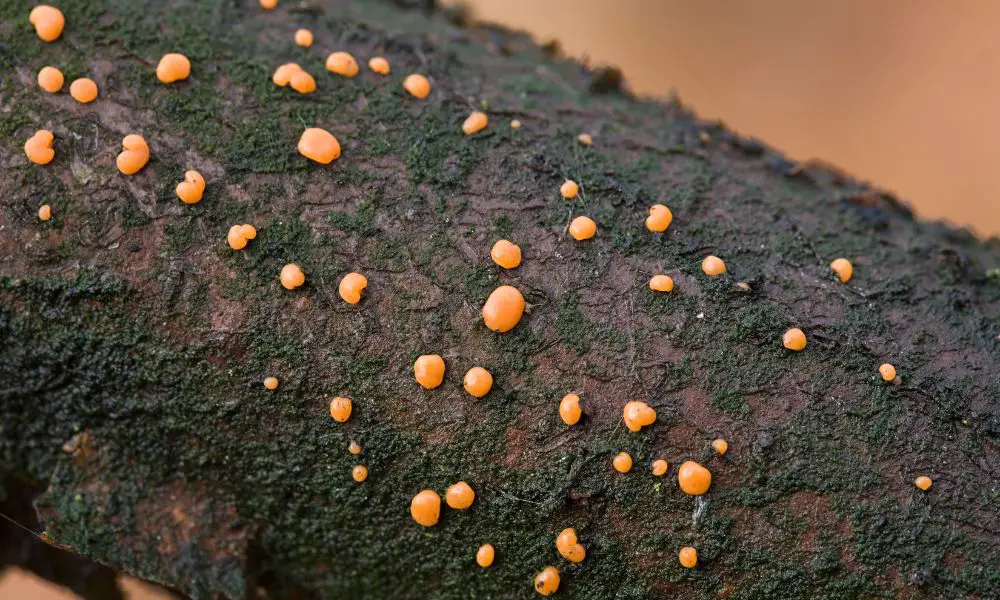
Coral spot is caused by Nectria cinnabarina fungus. It attacks most of the bonsai trees, causing die-back of parts of bonsai or even the entire tree.
This coral spot can be recognized by its salmon pink colored growths that are about the size of a pinhead and grow in colonies.
The fungus is commonly found on dead twigs and branches, but it can also infect living branches by infecting wounds on the branches.
There is a sudden withering of branches and laterals. There is the formation of fungus in the ligneous tissues. There is an appearance of red spots on the dead wood, as well as cankerous lesions.
If a serious infestation occurs, it will become a very frustrating situation as it will force you to drastically prune your bonsai tree.
Prevention and cure for coral spots on bonsai trees
- This fungus has a tendency to return. Furthermore, it is also likely to infect nearby bonsai trees. As a result, in severe cases, burning a bonsai is probably the most suitable option.
- All affected material should be pruned, and burned. When you are pruning the infected area, prune a few centimeters from the diseased area and not just at the location where the infection seems to end.
- The disease should be checked at the start of the growing season, especially during the spring, and then a systemic fungicide should be used throughout.
- Pruning wood should never be left lying around because hygiene is the most important factor in prevention.
- Using fresh bonsai soil will greatly reduce the chances of infection. In case you make your own bonsai soil, make sure the surrounding area is pest free. (also check the wooden board on which you mix your soil.)
- In case you have kept your bonsai outdoors, check the old stumps and old wooden items placed around the bonsai for coral spot disease.
- Before using a pruning tools, clean it with methylated or surgical spirits. Immediately after pruning, seal all the wounds with a cut paste.
- You can apply a copper based fungicide on to the pruning wounds.
IMPORTANT NOTE
In the absence of a systemic treatment, long-lasting, multipurpose, non-systemic treatments like copper fungicide and Bordeaux mixture can still be used as preventative treatments. Nevertheless, both of them use an enormous amount of copper, which causes a low-level pollution of the bonsai soil.
Furthermore, copper-based fungicides may occasionally have adverse effects on certain species of plants, such as Malus (eg. crab apple bonsai tree). The most effective preventative measure is generally the use of a multipurpose fungicide.
2.3. Verticillium wilt aka verticilliosis
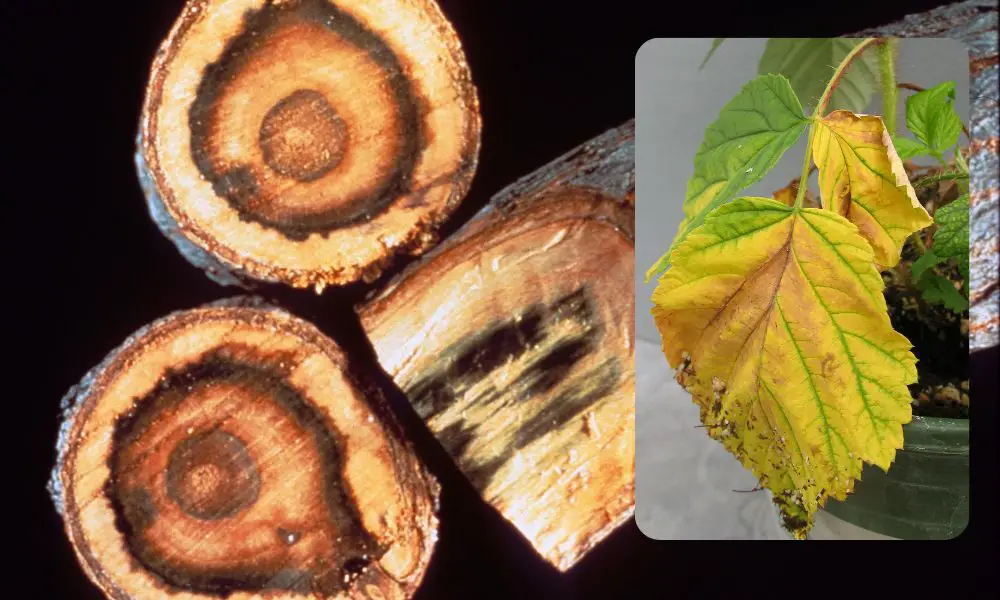
There are soil-dwelling fungi that cause this disease, and they survive on plant debris as well as in the soil.
A contaminated seed, plant, soil, and bonsai tool can spread the disease.
Water conducting vessels become plugged as fungi spread upward from roots to trunk to branches. Branches wilt and become discolored when water and nutrients are blocked from flowing to them.
The verticillium wilt attacks the sapwood of bonsai trees (especially maples – Hedge maple bonsai, Seigen maple bonsai, Kiyohime maple bonsai, Japanese red maple bonsai, Japanese maple bonsai, Amur maple bonsai, Trident maple bonsai), causing rapid branch and trunk die-back.
Known also as verticilliosis, verticillium wilt causes leaves to turn yellow, then brown and dry.
It is possible for leaves to wilt in hot weather. In addition, new leaves are stunted and yellow. Another symptom is, there is a sagging of leaves at the base of the tree.
An infected part spliced along its length will show longitudinal blackish striations in the sapwood.
The first thing you should do when peeling dying bark is look for streaks that are either dark or barely visible.
Some trees that are infected recover. However, some trees will die within a few months or over a period of several seasons.
Prevention and cure for Verticillium wilt on bonsai trees
- In case of confirmed infection, isolate the infected bonsai tree from other healthy bonsai trees. Also, keep separate tools for infected trees or sterilize the tools after each use.
- Ensure that any damaged parts of the tree are carefully attended to as soon as possible. Remove deadwood, dead leaves and weeds. The affected material should be cleared out, pruned off, and burned as soon as possible.
- However, do not rush into removing the branches which have recently wilted leaves. New leaves may appear on these branches in three to four weeks or in the spring.
- To stimulate vigorous growth, add fertilizer and water. However, don’t use too much nitrogenous fertilizer.
- You can treat the bonsai soil with a systemic fungicide containing Benomyl.
- You can also use cryselic acid to sterilize the soil.
- Make sure the soil is disinfected and the trunk and neck of the bonsai tree are sprayed with a mineral-based fungicide.
2.4. Powdery Mildew

Powdery mildew (a fungal disease – Oidium – a fungus with an external mycelium) appears as a thin layer of grayish-white powdery material on bonsai leaves, flowers, and young stems. (Species that are deciduous are usually most affected). The leaves start to discolor, weaken and dry. Additionally, the leaf blades become distorted.
There is an increase in patch size and a thickening of powder if the disease is not controlled in time. Moreover, withering leaves may have small black granules on them (in late fall mostly).
The combination of warm weather, high humidity, and poor air circulation through leaves and soil is a perfect condition for powdery mildew.
With their dense foliage, Trident Maple bonsai, for example, are often the victim of such attacks and the problem is usually viral in nature.
This is not a fatal disease, but an unsightly one.
The reason is usually a lack of air circulation, or the water didn’t have a chance to evaporate from a plant after it was sprayed too late at night.
Too much nitrogen in bonsai fertilizer can also cause powdery mildew. Overwatering can also be the cause of this disease. It is common for bonsai trees growing in shady areas to become infected.
Prevention and cure for Powdery Mildew on bonsai trees
- In most cases, prevention is better than cure when it comes to fungal control. Powdery mildew, for instance, is treatable with simple methods, but it has the potential to persist for a long time. As a result, you should treat potential mildew victims before they become infected.
- First and easy prevention methods you can opt for is choosing somewhat resistant varieties for making your bonsai and keeping your bonsai at a place with plenty of air circulation.
- Maintain a good pruning routine. While pruning is mostly done for looks and ramification, pruning to increase the air and light penetration will also be very helpful in the longer run.
- Remove deal foliage from the tree.
- Also, have a suitable bonsai watering schedule and avoid over-watering. Remember, less water to the bonsai is much preferable than more water.
- In case you don’t have a place where air circulation can be achieved naturally, you can also use a fan. But make sure that the fan is not blowing strong air directly to the bonsai tree.
- Preventive treatment should be carried out in spring if the tree had mildew the previous year.
- Remove the infected leaves. And as will all other fungal diseases, move the infected bonsai away from other nearby plants.
- Organic treatment: Add 1 liter of boiling water to 3 grams of dried wormwood. Allow to steep for 15 minutes, strain, cool, and use undiluted to treat aphids, mites, and mildew.
- You can use a homemade remedy (natural anti-mildew fungicide) by spraying a mix of water and milk (10:1) on the foliage of the tree. Or a mixture of baking soda (1 tablespoon), liquid soap (½ teaspoon) and water (1 gallon/3.7 liters).
- You can also use a Systemic Fungicide or Bordeaux Mixture.
- A systemic fungicide containing Benomyl is a good option. You can even use any sulphur-based fungicide.
- Myclobutanil or Mancozeb fungicides can also be used to prevent and cure powdery mildew.
- Preferably use a fungicide in powdered form.
2.5. Downy Mildew aka Botrytis / Gray mold
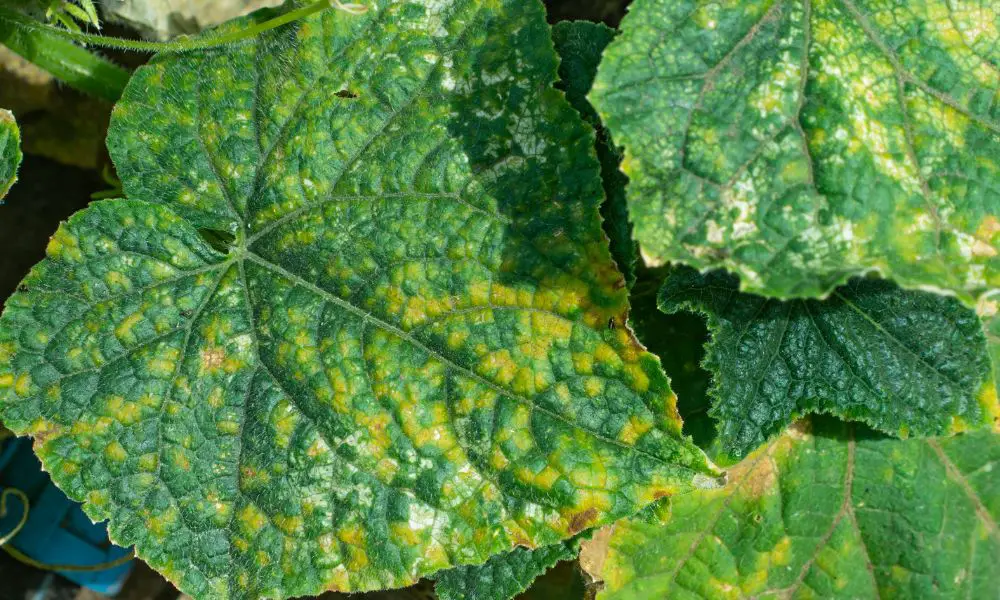
The downy mildew can appear on any part of the plant at any time.
A downy mildew infestation is usually characterized by gray mold on the underside of a leaf and yellow flecks on the upper side.
Moldy patches appear on the leaves surrounded by a halo. The patches dry out from the center outwards.
There is either insufficient air circulation or too much humidity in the soil and air surrounding the bonsai tree.
In most cases, downy mildew affects vines. A bonsai tree variety with soft leaves is also susceptible.
Prevention and cure for Downy Mildew on bonsai trees
- Relocate the infected bonsai to a well-ventilated area. Use a fan in case a naturally ventilated area is not accessible.
- Overwatering should be avoided.
- Remove and destroy the infected leaves.
- Treat the bonsai tree with a systemic fungicide.
- Chlorothalonil and mancozeb are good options for fungicide for downy mildew in bonsai trees.
- One more fungicidal solution you can prepare yourself is by mixing 2 tablespoons horticultural oil, 1 tablespoon sodium bicarbonate in 1 liter of water.
2.6. Peach leaf curl
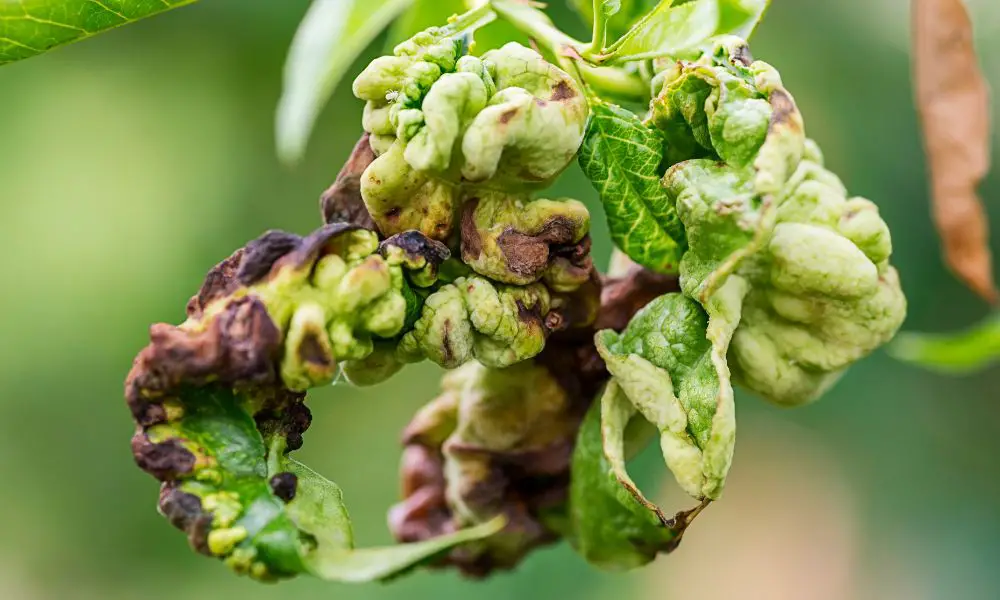
The peach leaf curl, also known as leaf curl, weakens trees (especially prunus bonsai species. Eg. – Japanese flowering apricot bonsai), damaging the leaves and shoots of the trees.
It is common to see red blisters appearing on the leaves. These blisters later turn white in color.
As a result, leaves become distorted and eventually fall from the tree prematurely.
Prevention and cure for peach leaf curl on bonsai trees
- The affected leaves should be pruned and destroyed as soon as possible
- Copper oxychloride-based fungicides can be used to treat peach leaf curl.
- You can also use Mancozeb fungicide.
2.7. Anthracnose
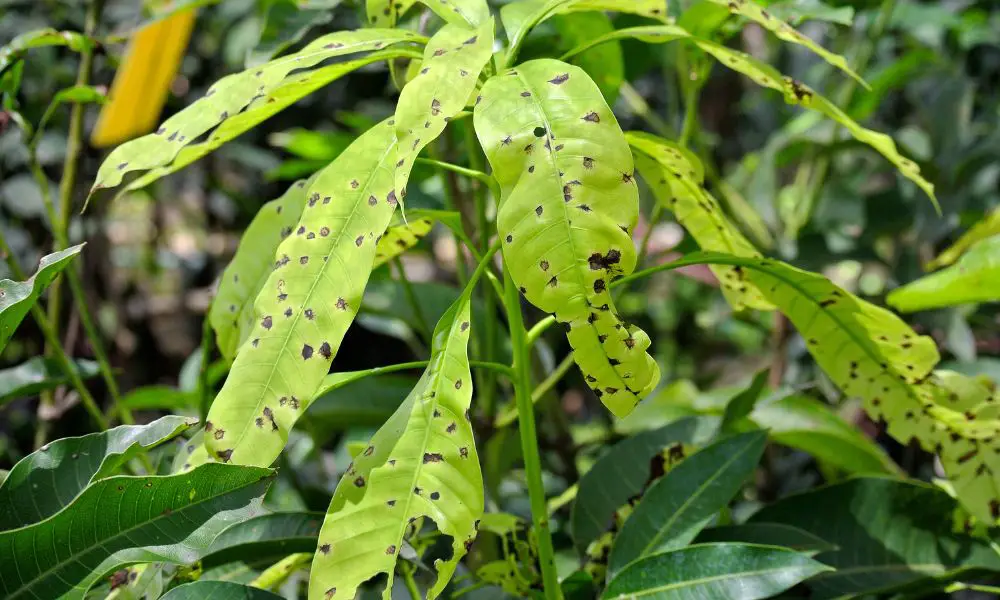
This disease is caused by a fungus that lives on fallen leaves or in sunken cankers on twigs during the winter.
Rain and overhead watering further increase the chances of spreading this fungus. As the water splashes the spores onto the young foliage.
Leaves on infected trees develop dark spore-producing structures on their bottoms. Brick-colored sunken spots appear on the leaves and sometimes on the lamina.
These dead spots expand in size and cause defoliation of the infected foliage. However, new leaves will soon appear in the spring or early summer.
Chemical control is not necessary for trees affected for one year. However, it is worth noting that if the tree is infected for multiple years, then there is a chance of ranch dieback.
Maple bonsai trees are mostly affected by this fungus. On infected maple bonsai trees, you will see these spots in May to August.
Prevention and cure for Anthracnose on bonsai trees
- To prevent reinfection, pick up and destroy old foliage and deadwood.
- The chances of infection are also reduced by removing dead twigs below the bark canker.
- Copper-based fungicides should be sprayed along with sulfur based powder fungicide.
- In the event of wet and humid springs in the following years, bonsai trees should be treated with a chemical fungicide or a Bordeaux mix. However, be very careful while using this solution (mix of copper sulfate, lime, and water) as it will burn the foliage in moist conditions
- You can also use neem oil.
2.8. Fire blight
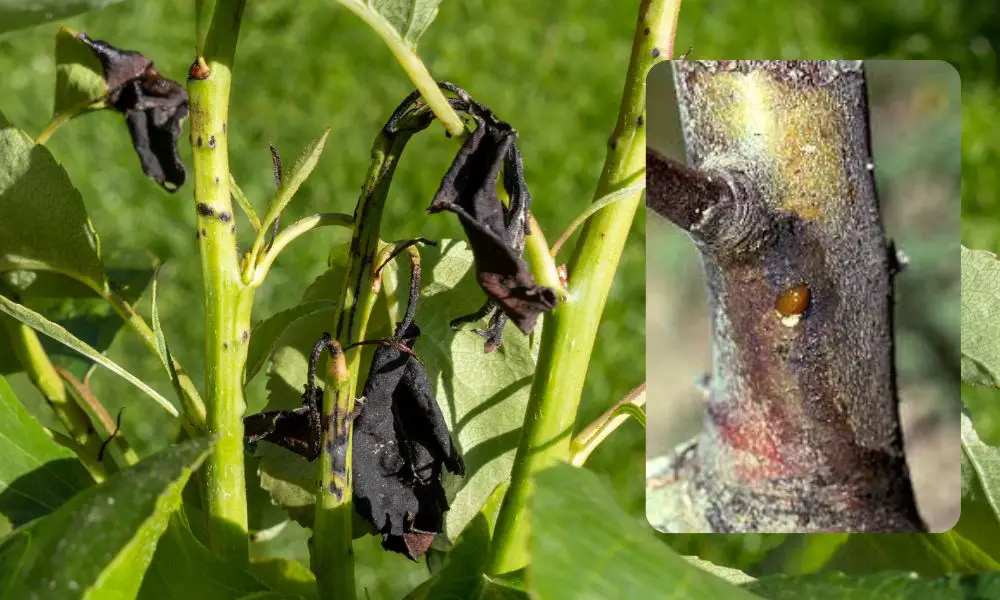
Fire blight disease is highly contagious and destructive.
The disease begins at the tips of branches before spreading down the stems and causing dieback. The disease attacks soft new growth first, resulting in dieback at the top of the plant.
In addition to flowers, leaves, shoots, branches, and fruits, fire blight attacks roots as well.
Some of the bonsai trees that are affected by this disease are flowering quince, cotoneaster, hawthorn, loquat, crabapple, prunus species, pear, and rose.
There is rapid browning or blackening and wilting of the leaves and branch tips of infected trees. The foliage looks to be burned with a deep rust color. The foliage withers but does not fall from the tree. Even the dead fruits reamin on the tree.
Reddish water-soaked lesions also develop on the bark of trees. Also, there may be cracks in the bark at the edge of the infected area. Orange-brown liquid oozes from these lesions on warm days.
Prevention and cure for Fire blight on bonsai trees
- Remove all the infected parts of the bonsai and burn them.
- Choose a disease resistant cultivar. Some of the root rot resistant species that can be used to make a bonsai are Alaska cedar, America arborvitae, dwarf mugho pine, Hiryu azalea, Pfitzer juniper, sasanqua camellia, Savin juniper, Sawara cypress.
- Avoid overhead bonsai watering.
- Managing fire blight properly requires preventing blossom infection since infection initiated in flowers is destructive.
- Apply a copper sulphate-based fungicide.
- Avoid high nitrogen fertilizer specially during the summer.
2.9. Needle cast

The needle wall of leaves becomes spotted with yellow and orange bands, but in later stages of the disease, black spots appear along the needle wall.
However, the same symptoms are seen when the needles turn red at the tips when proper feeding practice is not followed. So, before proceeding with any remedy, make absolutely sure that your bonsai tree is infected with needle cast.
The infected needles turn red, dry and eventually fall.
Prevention and cure for needle cast on bonsai trees
- Prune and remove infected foliage. Also, remove any infected debris from the soil surface.
- Make sure that the bonsai soil is not too wet.
- Spring is a good time to spray with fungicide as a precaution.
- It is possible to treat needle cast with a contact spray using a copper-based fungicide.
- In mild weather, the solution can be applied as a foliar spray at two-week intervals during the growing season and during dormancy.
2.10. Root rot
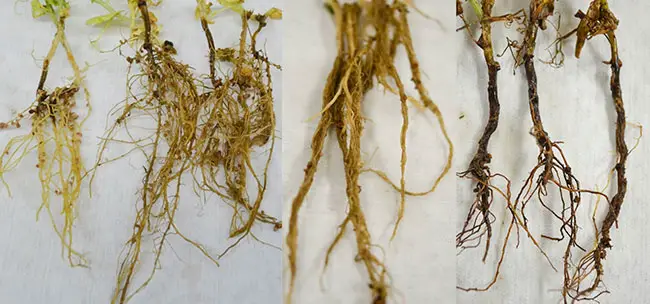
In some cases, root rot can be caused by overfeeding, but it occurs more commonly after a tree has been left in water for too long.
A few weeks or many months can pass before root rot symptoms appear.
It does not take long for the delicate roots to become slimy, turn brown, rot and die.
Under the bark, white patches (mycelium) and black threads (rhizomorphs) can also be seen.
Near the soil, the tissue under the bark becomes darkly discolored. Check the plant’s bottom bark for discoloration by peeling it back. Wood that is white and healthy is distinct from wood that is dark and diseased.
Another symptom of root rot is that the foliage will start to brown and some of the branches will die. The dead foliage is rolled along the midrib.
One more sign of root rot is very weak shoot extension and dehydration wrinkles on the bark of the tree in the spring.
At the base of the tree, yellow-capped fungi appear in the fall with brown scales and white gills. These patches will start spreading on the tree.
Prevention and cure for root rot on bonsai trees
- Prevention of root rot can be achieved by making sure the bonsai soil is free draining.
- You can also make a mound of the soil for improved drainage of water.
- Make sure you choose varieties that are resistant to wilt and root rot.
- Inspect the roots carefully at the time of repotting.
- Method 1 : Plant the bonsai in a temporary container with very sandy light soil after removing the outer soil. Use vitamin B-1 transplant solution to water the plant in, soil only. The foliage should be misted regularly with water, but the roots should be kept dry. Treat this bonsai as you would a stem cutting. The tree will recover if the root rot was not very severe.
- Method 2 : To prevent further rotting, remove all rotted root pieces and dip the healthy roots in a benomyl solution. Afterward, repot the plant in a new pot and water thoroughly, but from then on, water less frequently (because root damage prevents a plant from absorbing as much water as a thriving plant). Wait at least eight weeks before feeding your bonsai again. As the bonsai tree recovers, keep it out of direct sunlight as it needs tender care. Read do bonsai trees need sun for more details.
2.11. Canker

Bonsai trees often develop cankers as a result of improper pruning technique and not properly caring for pruning wounds. These wounds when infected by fungal or bacterial pathogen develop cankers.
Cankers mostly occur on woody plants.
Cankers are not only caused by pruning wounds, but also by unintentional/intentional damage to the tree’s bark.
It is most likely that cankers will also occur on plants that have been weakened by cold or drought stresses, nutritional imbalances, nematodes, or root rot.
A canker disease often kills branches or weakens a plant’s structure until the infected area breaks free in the wind.
First signs of decline due to canker usually appear on the new leaves on affected branches. In these plants, the leaves are often curled and sparse, pale green to yellow, or brown in color.
A canker typically appears on the bark of trunks, branches, or small twigs as sunken, slightly discolored, brown-to-reddish lesions.
Often, the bark splits between the diseased and healthy tissues, and sometimes “Amber-color pitch” is oozed from it. In some cases, the inner bark turns black and smells foul.
Prevention and cure for canker on bonsai trees
- There is no specific chemical control for cankers in plants.
- Always use sterilized pruning tools (you can use rubbing alcohol).
- Cutting away an infected branch or removing infected tissue is the only effective way to control canker. If possible, do this in dry weather.
- Seal the wound after you do your maintenance pruning.
- All diseased wood should be burned immediately, and all tools should be sterilized.
- Follow some best practices such as: (a) growing adapted or resistant varieties, (b) avoid over watering (c) Do not overcrowd your bonsai trees (d) Protecting young trees from Sunburn by wrapping them (e) fertilizing plants to keep them vigorous (f) make sure that the soil is well drained.
- Also check for woolly aphids (Eriosomatinae) on the tree.
2.12. Rust
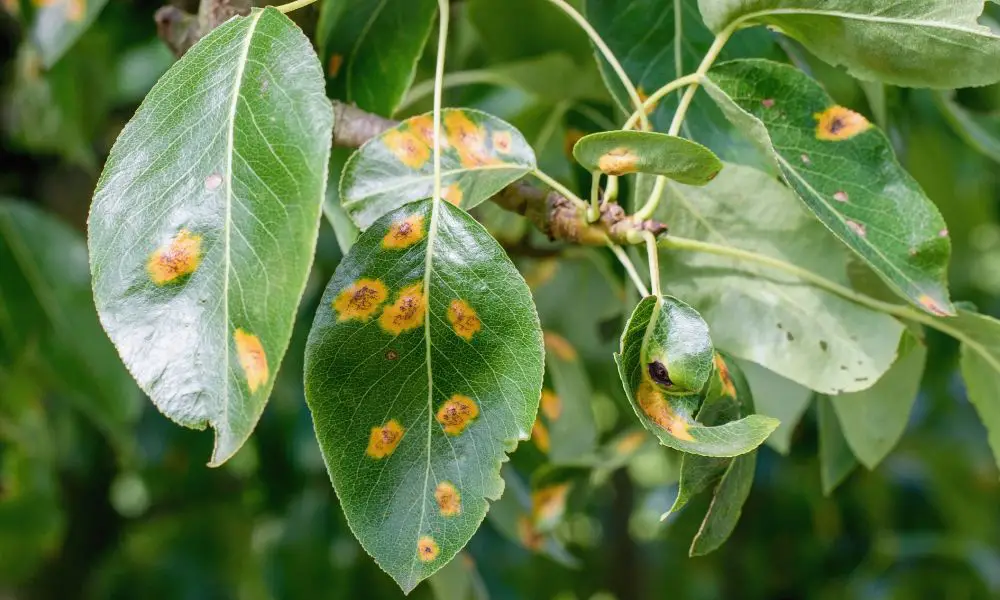
This is a fungal disease that affects the foliage of bonsai trees. Brown, yellow, red or orange patches (or sometimes black powdery blisters) appear on the topside or underside of the leaves. The leaves curl and eventually drop off the tree.
These discolored patches sometimes appear on the bark of the tree. These long yellow patches develop into blisters and eventually burst to release orange Resin. The branch also grown in a curved fashion (S-shape). As the shoot withers, the growth of the branch is disrupted.
Stems infected with this disease may swell or blister, or they may develop oblong or horn-like galls.
Phragmidium fungus, which also thrives in a humid, hot environment, causes these patches and blisters. Trees and shrubs of both deciduous and coniferous origin are susceptible to various types of rust fungi.
Rust growth is commonly accelerated by excess potassium.
Rust spores are spread by wind and splashing water. The spores germinate and infect plant tissues when the conditions are favorable (moist, between 55°F and 75°F / 12°C to 23°C).
Prevention and cure for rust on bonsai trees
- There are some rust fungi that are rather harmless and do not require any control measures to be taken.
- It is very important to destroy fallen leaves in fall so that rust does not overwinter and spread.
- Maintaining good air circulation prevents the development of rust.
- Do not water a rust susceptible bonsai tree from the top. As overhead watering will increase the chances of spreading the fungus in the foliage.
- It is possible to scrape or rub off the powdery material. The affected parts of the bonsai should be cut away and burnt, as well as the pruning wounds cleaned.
- An “anti-rust” fungicide should be sprayed on the plant. It may be necessary to repeat this process after 2 weeks. Ensure that you do not apply too large a dose of treatment to the tree, as it may cause damage to the tree.
- You can use a fungicide Zineb or Propiconazole.
2.13. Scab
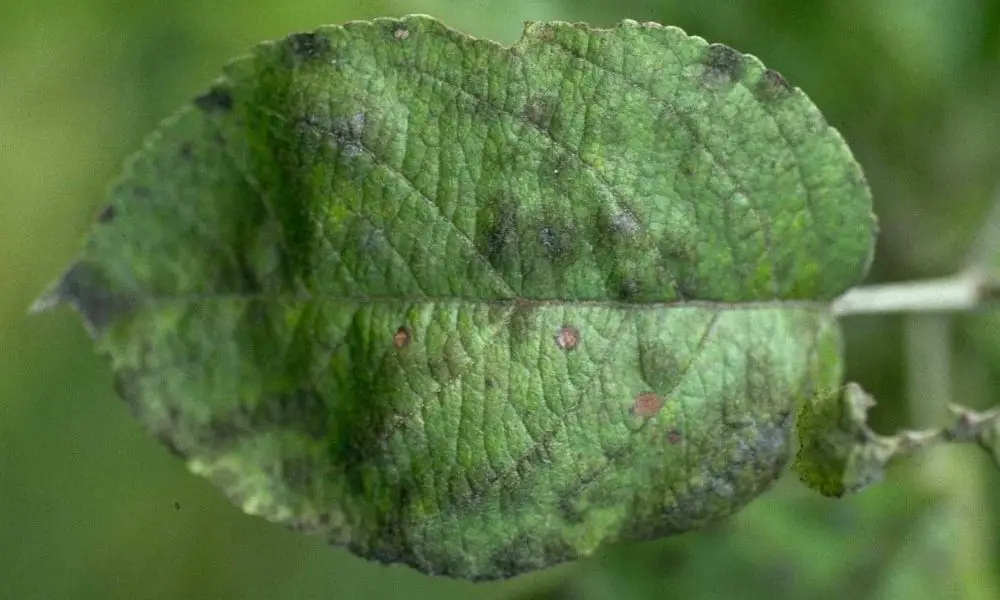
It is possible for scab fungus to cause a great deal of damage.
The scab fungus, also known as Cladosporium, causes large patches on the undersides of leaves as well as gray mildew.
There is an appearance of brownish green patches on the fruit that bursts, as well as on the leaves and shoots.
Prevention and cure for scab on bonsai trees
- Provide good air circulation to the bonsai tree.
- The affected leaves should be destroyed in the fall.
- A copper-based fungicide and a calcium oxychloride-based fungicide can be used to control scab.
- You can use Mancozeb or Myclobutanil fungicide.

